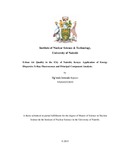| dc.description.abstract | Air pollution is a widespread problem affecting millions of people exposed to high
levels of air pollution that exceed one or more ambient limit values. One of these air
pollutants is the airborne particulate matter (PM), which is composed of a broad class
of chemically and physically diverse substances. PM varies in size, chemical
composition, formation mechanism and origin. In order to formulate mitigation
policies and control measures, there is need to identify the sources. In the recent past
Nairobi city has gone through rapid and haphazard urbanization under the pressure of
rural to urban migration. On the other hand there has been a huge unprecedented
increase in the number of on-road vehicles, rapid establishment and growth of the
informal sector, industries and uncontrolled burning of biomass and waste among
other anthropogenic activities. These activities contribute heavily to urban air pollution
and understanding of the current situation is very important in view of implementing
Kenya Vision 2030 and the Millennium Development Goals. In this study airborne PM
samples were collected for 8 hours on filter media using BGI 400 personal samplers at
two selected locations; at Mines and Geology premises (Industrial site) and University
of Nairobi main campus in Nairobi city (CBD site) for a period of 2 weeks in the
month of January/February in 2012. PM2.5 was sampled simultaneously at two sites in
each location; at 1.5 m above ground (abg) at both locations and at 14m abg at
industrial site and 17 m at CBD. Sampling was done at alternate times; morning
(0700h-1500h) and afternoon (1200h-2000h) on alternate days. Analysis of trace
elements in the samples was done using EDXRF spectrometer and Quantitative X-ray
Analysis Software (QXAS) was used for spectra analysis and elemental quantification.
Principal Component Analysis (PCA) was used to identify the sources of the sampled
particles using the evaluated elemental concentrations in all the samples. Mean
daytime concentration of PM2.5 at both sites ranged from 1 to 260 µgm-3. The PCA
components apportioned mineral dust, industrial emissions, traffic related emissions
and biomass burning as the main sources of particulate matter in Nairobi area. Mn, Fe,
Cu and Zn registered high concentration and implied mineral dust was a major source
of PM2.5 in Nairobi. In vertical dispersion, PM concentration near ground was higher
than those collected at the rooftop by a factor of 1 to 8 in most of the days and less
than 1 in a few days. These heavily influences urban air quality thus formal legislation
need to be set. | en_US |

